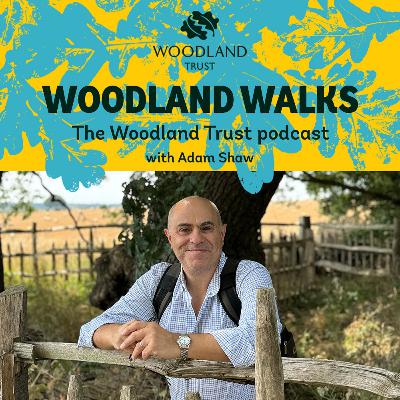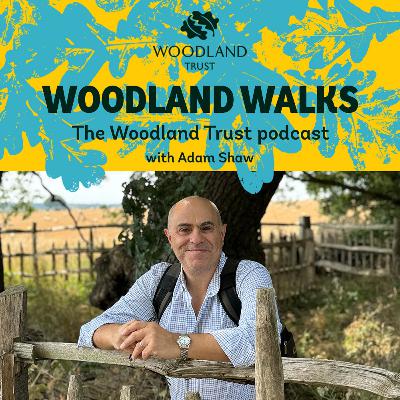8. Spotting signs of spring: why noticing nature boosts wellbeing and supports science
Description
Spring is in the air! Join us at Londonthorpe Wood, Lincolnshire to enjoy the wellbeing benefits of woods while using all our senses to check for signs of spring. We seek out frogspawn, song thrushes and blackthorn blossom for Nature's Calendar, a citizen science phenology project which tracks the effects of weather and climate change on nature across the UK.
Keeping your eyes and ears peeled to record for Nature's Calendar doesn't just support science. Discover new research that shows how engaging all our senses on a woodland walk is good for our wellbeing, and how different levels of biodiversity in each wood can impact the positive effects of being in nature.
Don't forget to rate us and subscribe! Learn more about the Woodland Trust at woodlandtrust.org.uk
Transcript
You are listening to Woodland Walks, a podcast for the Woodland Trust presented by Adam Shaw. We protect and plant trees for people to enjoy, to fight climate change and to help wildlife thrive.
Adam: Well, this month I'm off to Grantham in Lincolnshire, which is a bit to the right of Nottingham and quite a bit below Sheffield, if you're not clear on your geography. Anyway, I'm here to investigate a Woodland Trust project called Nature's Calendar, which tracks how the seasons are changing over time and if, for instance, the timing of spring is starting earlier. Now, if that is happening, that's not a minor thing, because all of nature depends on, well, the rest of all of nature. So if one thing changes, it can cause big changes everywhere. Now, this is all part of citizen science, and if you don't know that phrase or haven't heard it before, it means the data is collected from people of all ages, backgrounds, abilities, not necessarily by scientists, in fact, probably not by scientists. Anyone can volunteer and the volunteering work is incredibly important. Volunteers have been recording the changing seasons with Nature's Calendar for 20 years, and the database they have built contains 2.9 million records. It's believed to be the longest written biological record of its kind in the UK, and it's used by researchers from across the world to explore the effects of weather and climate on timings in wildlife. And a brief word for those who like new words, here's one for you: phenology. That's what this project is all about. The study of seasonal changes in plants and animals from year to year. Phenology. Now, that word was invented by a botanist called Charles Morren in around 1849. But even before they had a name for it, people were busy recording what was happening in nature and Britain was really at the forefront of much of this work. Robert Marsham was Britain's first phenologist, doing his work before the name was invented for his field of study, and he recorded his quote 'indications of spring' from around the year 1736. Anyway, all of that is a huge historical meander so let's get to the events of today with a real meander around Londonthorpe Woods with one of the Woodland Trust's experts.
Here we are. Whenever you're ready!
Sally: Okay, I'm Sally Bavin. I'm a monitoring and evaluation adviser for the Woodland Trust and we are currently at Londonthorpe Woods, near Grantham.
Adam: Right, well, thank you very much for joining me here. It's a chilly day, but we're good on the, we're good on the rain for the moment. So what is the purpose of what we're doing here? Where are you taking me today and why?
Sally: We've we've come out to the woods today to enjoy some of the wellbeing benefits of visiting woodlands and particularly looking out for signs of spring using all of our senses. So, yeah, it should be quite a quite an enjoyable one.
Adam: Fantastic. And this fits in with part of a campaign the Woodland Trust is running. Is that right?
Sally: Absolutely, yes, so we have at the moment we're asking people to look out for the vital signs of spring, as we're calling it. So we've picked out three things of interest that are frogspawn, the song of the song thrush returning for the spring, and the first blackthorn flower.
Adam: Right. And that's what we're going to try and spot today.
Sally: We will have a go. Yeah, we might be a bit early for some, but this is the the interesting thing to see what's out and about at the moment.
Adam: And on a previous podcast we were here together looking to sort of identify trees. I'm going to be super impressed if you can identify birdsong as well. Are you good at that?
Sally: Well, I know the song thrush. That's the one we're listening out for *laughs* so I'm not too bad. You'll have to test me as we go along.
Adam: Okay, so we're at Londonthorpe Woods, which is, happens to be near Grantham, which is where the Woodland Trust is actually based. So all very lovely. Which way?
Sally: I assume we're editing lots of…
Adam: No, no, no, all this confusion is, is in *both laugh*. That way.
Sally: Okay.
Adam: Right. If you're hearing noises off, it's because Alex from the Trust is joining us. She's part of the brains of the operation and also doing social media videos. So I'm gonna look particularly daft with my, headset on, talking into a little box. Anyway, so, okay well, we're already leaving the woodlands. That was a quick visit. We're crossing the road. Is it because there's a pond over here?
Sally: Yes. So the first thing we're going to look for, is frogspawn. And as we are walking towards the pond, I could tell you about some research that the Woodland Trust has funded, but let's wait till we get away from the road.
Adam: I was gonna say we just crossed not a very busy road that got very busy as we were crossing it. Okay, let's go through here, away from the road and into another bit of woodland.
Sally: So I think to get to the pond, I think it's that way. And then that way.
Adam: Okay, you're not filling me with confidence. You've only taken two directions, and you're not sure of either of them at the moment, but okay *both laugh*
Sally: Yeah. So as we're walking along, the idea is to be using all of your senses to engage with the landscape that we're in. So I've just seen a robin fly past there, but, yeah so…
Adam: But robins aren't a sign of spring?
Sally: They sing all year round, they're a good constant through the winter. Thank goodness for the robin otherwise we wouldn't really have much birdsong in the winter at all.
Adam: And they look lovely, robins, but actually they're they're quite territorial, they've, a lot of them come to my bird feeder in my garden and they're, they're proper brave! I mean, I'll go out and the robin looks at me like, come on, get the nuts out, get the seed, they're not scared. They're quite territorial, looks like quite territorial birds, I think. But go on, you you were wanting to tell me?
Sally: So one of the birds that we're listening for is the song thrush. That is because, it's a bird, which generally, it starts singing early spring, and it's a species that's been recorded for Nature's Calendar for many years now. So it's one that we're asking people to look out, to listen out for even, engaging all your senses, because it's quite a distinctive song, so if we do hear one, then that would be great.
Adam: And then where do they go then, in the winter, then, migratory, migratory, oh, gosh, I can't even say that word properly. But anyway, they're not always here, perhaps is a better way to describe them.
Sally: We do have resident song thrush, but it's the singing behavior that starts in the spring.
Adam: Oh does it? And is that all about attracting, you know, mates?
Sally: Yeah, yeah, it's the the springtime rush for romance, yeah.
<span lan














